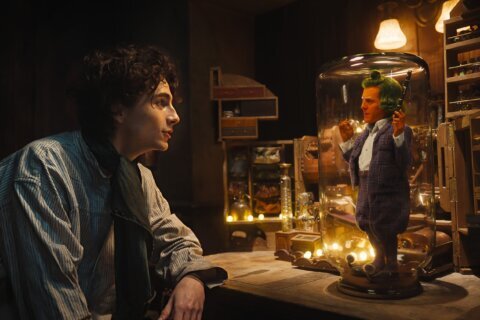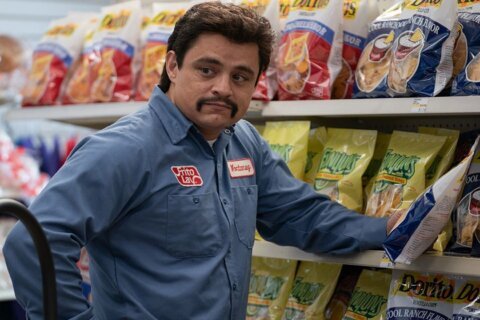Jason Fraley, WTOP Film Critic
WASHINGTON – Do you love the smell of napalm in the morning?
This week brings a special way to honor the military as we march toward Memorial Day.
The G.I. Film Festival kicks off Monday and runs through Sunday, with movies being shown at various locations around the District.
The films focus on the sacrifices of the military, including “Doughboy” (2012), which features real-life vets sharing thoughts on patriotism, freedom, and the attitudes of today’s youth.
The sixth-annual festival also features panel discussions, educational forums and special events.
Click here for a full list of screenings.
The festival inspired us at WTOP to ask for your favorite war films. Here are some of the essentials (in reverse chronological order):
![]()
The Hurt Locker (2008)
It may be remembered as the movie that knocked off “Avatar” (2009) for Best Picture, but Kathryn Bigelow’s “Hurt Locker” is a timely study of a U.S. bomb squad on the streets of Iraq. Whether in the line of fire, or in the grocery store aisle, the film is emotionally riveting.
![]()
The Patriot (2002)
It got mixed reviews upon its release, but I have a feeling “The Patriot” will gain in stature over time, due to the untimely death of Heath Ledger and the increased popularity of Jason Isaacs as a villain in “Harry Potter.” We may also long for the days when Mel Gibson didn’t make career-killing comments off-screen, choosing to remember his on-screen madmen like the title character in “Mad Max 2: The Road Warrior” (1981), Martin Riggs in “Lethal Weapon” (1987) and William Wallace in “Braveheart” (1995). His Benjamin Martin is just as bloodthirsty, moving from pacifist farmer to revolutionary.
![]()
Saving Private Ryan (1998)
Steven Spielberg’s D-Day depiction was so lifelike that many veterans had to leave the theater during the opening sequence. With mesmerizing action and the deepest of casts, “Private Ryan” is ultimately a tale of sacrifice, where eight men (led by Tom Hanks) risk their lives for just one (Matt Damon).
![]()
Forrest Gump (1994)
“They’re sending me to Viet-nam. It’s this whole other country.” Okay, so “Forrest Gump” isn’t solely a war film, any more than it’s a football or ping pong movie. But the film is touched by Vietnam throughout, including Forrest flying in to “Fortunate Son,” winning the Medal of Honor, showing LBJ his “buttocks” wound, speaking at a Vietnam War protest, fulfilling his wartime promise to Bubba by becoming a shrimp boat captain, and helping Lt. Dan in his legless, post-war reintegration to society.
![]()
Schindler’s List (1993)
When Tom Hanks and Steven Spielberg produced the brilliant TV series “Band of Brothers,” they featured an episode called “Why We Fight,” showing the liberation of a Nazi concentration camp. “Schindler’s List” shows exactly why we fight.
![]()
Gettysburg (1993)
This four-and-a-half hour epic, based on the novel “The Killer’s Angels,” covers the pivotal Civil War battle, from Little Round Top to Pickett’s Charge. Starring Tom Berenger, Martin Sheen and Jeff Daniels, it remains a popular favorite.
Glory (1989)
How’d you like to see Morgan Freeman and Denzel Washington at the top of their respective games — both in the same movie? Denzel won the Oscar for Best Supporting Actor in this tale of the first all-black regiment, literally fighting for freedom during the Civil War. Few moments are as powerful as the tear down Denzel’s cheek as he stares at Matthew Broderick while being whipped in the back.
![]()
Full Metal Jacket (1987)
Stanley Kubrick’s second to last film may hold the record for fastest turn from hilarious to horrific. R. Lee Ermey’s profanity-laced boot camp speeches turn on a dime as the young recruits are dropped in Vietnam. The film features a killer rock soundtrack and one of the most disturbing lines in war movie history: “How can you shoot women and children?” “Easy. Just don’t lead them so much.”
![]()
Platoon (1986)
Many war movies are written by Hollywood types who have never experienced battle. “Platoon” was so powerful because it was written/directed by Vietnam vet Oliver Stone. Starring Charlie Sheen, Tom Berenger, Willem Dafoe, Forest Whitaker, Keith David and Johnny Depp, the film’s most haunting element is its use of Samuel Barber’s “Adagio for Strings.”
![]()
Apocalypse Now (1979)
A typhoon destroying sets. A Martin Sheen heart attack. Marlon Brando showing up overweight and unprepared. Dennis Hopper stoned out of his mind. And a hellacious over-budget shoot that zapped the genius of Francis Ford Coppola. This plunge into Joseph Conrad’s “Hearts of Darkness” remains history’s greatest tableau of war’s effect on the psyche. “The horror. The horror.”
![]()
The Deer Hunter (1978)
Michael Cimino’s Best Picture features one of the most intense scenes in any movie: Robert DeNiro and Christopher Walken forced to play Russian Roulette against each other. Still, the film spends little time in Vietnam. It’s mostly about the effects (physical and mental) on the troops after they return home. It’s also the last film with Meryl Streep and boyfriend John Cazale before his untimely death.
![]()
Patton (1970)
Two years before directing “The Godfather” (1972), Francis Ford Coppola won the Oscar for writing this gem of a script, deserving for the opening speech alone. The film features classic music by Jerry Goldsmith, but its best element is no doubt the title performance of George C. Scott. Iconic.
![]()
Tora! Tora! Tora! (1970)
It was billed as “The most spectacular film ever made,” and many fans would agree. It remains one of the most balanced portraits of Pearl Harbor, and the many mistakes that allowed it to happen.
![]()
M*A*S*H (1970)
Few films have been so hilarious and so disturbing, simultaneously. Robert Altman’s ensemble look at battlefield surgery in the Korean War is summed up in the title of its memorable theme song: “Suicide is Painless.” It truly was a cultural moment, inspiring one of the most popular TV series of all time.
![]()
The Dirty Dozen (1967)
It was “The Magnificent Seven” (1960) meets World War II; an ensemble cast of ’60s tough guys. Who wouldn’t want to see Lee Marvin, Ernest Borgnine, Charles Bronson, Jim Brown, George Kennedy, John Cassavetes and Donald Sutherland, all directed by Robert Aldrich (“The Longest Yard”)?
![]()
The Battle of Algiers (1966)
Gillo Pontecorvo’s masterpiece depicts the bloody Algerian revolution, as Algerians seek independence from French colonialists. It plays out so realistically, that we think we’re watching a documentary. The war scenes foreshadow much of the modern warfare (i.e. suicide bombs) we’ve come to know in today’s wars.
![]()
The Great Escape (1963)
John Sturges’ tale of Allied troops escaping a German P.O.W. camp set the stage for TV’s “Hogan’s Heroes” and features a stellar cast, including Steve McQueen, James Garner, Richard Attenborough, James Coburn, Donald Pleasence and Charles Bronson. You can still see McQueen’s motorcycle jump at the start of many MGM DVDs.
![]()
The Longest Day (1962)
When he wasn’t doing westerns, John Wayne was appearing in war flicks. And of all The Duke’s military movies, from “Sands of Iwo Jima” (1949) to “The Green Berets” (1968), “The Longest Day” is his best, sharing the screen with Robert Mitchum, Sean Connery, Henry Fonda and Richard Burton.
![]()
Lawrence of Arabia (1962)
David Lean’s epic tells the tale of T.E. Lawrence leading an Arab revolt against the Turks in World War I. With powerful music by Maurice Jarre and an unforgettable performance by Peter O’Toole, this film is just as relevant in today’s era of war in the Middle East as it was in 1962.
![]()
The Bridge on the River Kwai (1957)
David Lean’s “Bridge on the River Kwai” provides three treats: (a) The catchiest whistling tune of all time, (b) Alec Guiness’ wobbly-legged walk out of a Japanese P.O.W. camp, and (c) an explosive finale that still has the power to drop our jaws.
![]()
Paths of Glory (1957)
Thirty years before “Full Metal Jacket” (1987), Stanley Kubrick directed Kirk Douglas in this classic tale of World War I morality, setting the stage for their pairing in “Spartacus” (1960) three years later.
![]()
Stalag 17 (1953)
Three years after teaming on their masterpiece “Sunset Boulevard” (1950), William Holden and director Billy Wilder teamed on this classic war film that earned Holden the only Oscar of his career.
![]()
From Here to Eternity (1953)
Fred Zinnemann’s Best Picture triumph tells of love and loss on Hawaii’s most infamous military base in the days before Pearl Harbor. Even with Burt Lancaster, Deborah Kerr, Frank Sinatra, Donna Reed and Ernest Borgnine, Montgomery Clift steals the show with his bugle rendition of “Taps,” a tear-jerking salute to fallen soldiers.
![]()
The Best Years of Our Lives (1946)
Before “Coming Home” or “Born on the 4th of July,” William Wyler’s masterpiece portrayed the difficulties of returning home from war. Actual World War II amputee Harold Russell won an honorary Oscar, and the scene of Fredric March returning home to his family gets me every time.
![]()
Sergeant York (1941)
Director Howard Hawks could handle any genre: comedy (“His Girl Friday”), western (“Red River”), gangster (“Scarface”), noir (“The Big Sleep”), and musical (“Gentleman Prefer Blondes”). “Sergeant York” proved he could also direct a classic war film, earning Gary Cooper his first Oscar as a pacifist who becomes a sharpshooting hero in World War I.
![]()
La Grande Illusion (1937)
Woody Allen called it the greatest movie ever made. Jean Renoir’s masterpiece was the first film selected for the Criterion Collection, influencing everything from “Casablanca” (1942) to “The Great Escape” (1963) to “The Shawshank Redemption” (1994).
![]()
All Quiet on the Western Front (1930)
The director of this World War I epic was fittingly named Lewis Milestone, as “All Quiet on the Western Front” was a milestone in early “talkies” and the third Best Picture winner in Oscar history.
![]()
The Big Parade (1925)
King Vidor was a king of the silent age, directing this World War I tale to become the highest grossing silent movie ever at $22 million. Many film highlight reels feature its famous scene of a soldier riding off to war, as his girlfriend holds onto his hand as long as possible.
![]()
Battleship Potemkin (1925)
Sergei Eisenstein’s silent film pioneered the era of Soviet Montage and has influenced countless filmmakers to follow. Its famous scene of a baby carriage bouncing down the Odessa Steps has been recreated in everything from “The Untouchables” (1987) to “Naked Gun 33 1/3” (1994).
![]()
What are your favorites? Comment below or weigh in on our Facebook page.
Read more from WTOP Film Critic Jason Fraley by clicking “Fraley on Film” under the “Living” tab above, following @JasonFraleyWTOP on Twitter, and checking out his blog, The Film Spectrum.
(Copyright 2012 by WTOP. All Rights Reserved.)








